HI6006 - Strategy Development Tools: Application in Business
VerifiedAdded on 2023/06/08
|6
|1686
|171
Essay
AI Summary
This essay provides a comprehensive analysis of strategy development tools used by organizations, focusing on frameworks like SWOT, PESTLE, and Porter's Five Forces. The SWOT framework is examined for its role in analyzing the internal environment, covering strengths, weaknesses, opportunities, and threats. The PESTLE framework is discussed in terms of its analysis of the external environment through political, economic, social, technological, legal, and environmental factors. Porter’s Five Forces framework is explored for its application in industry analysis, including competitive rivalry, supplier power, buyer power, the threat of substitution, and the threat of new entrants. The essay also touches upon Porter’s Generic Strategies model, highlighting cost leadership and differentiation strategies. Examples, such as the analysis of Woolworths, are used to illustrate the practical application of these frameworks. Desklib provides access to similar solved assignments and study resources for students.
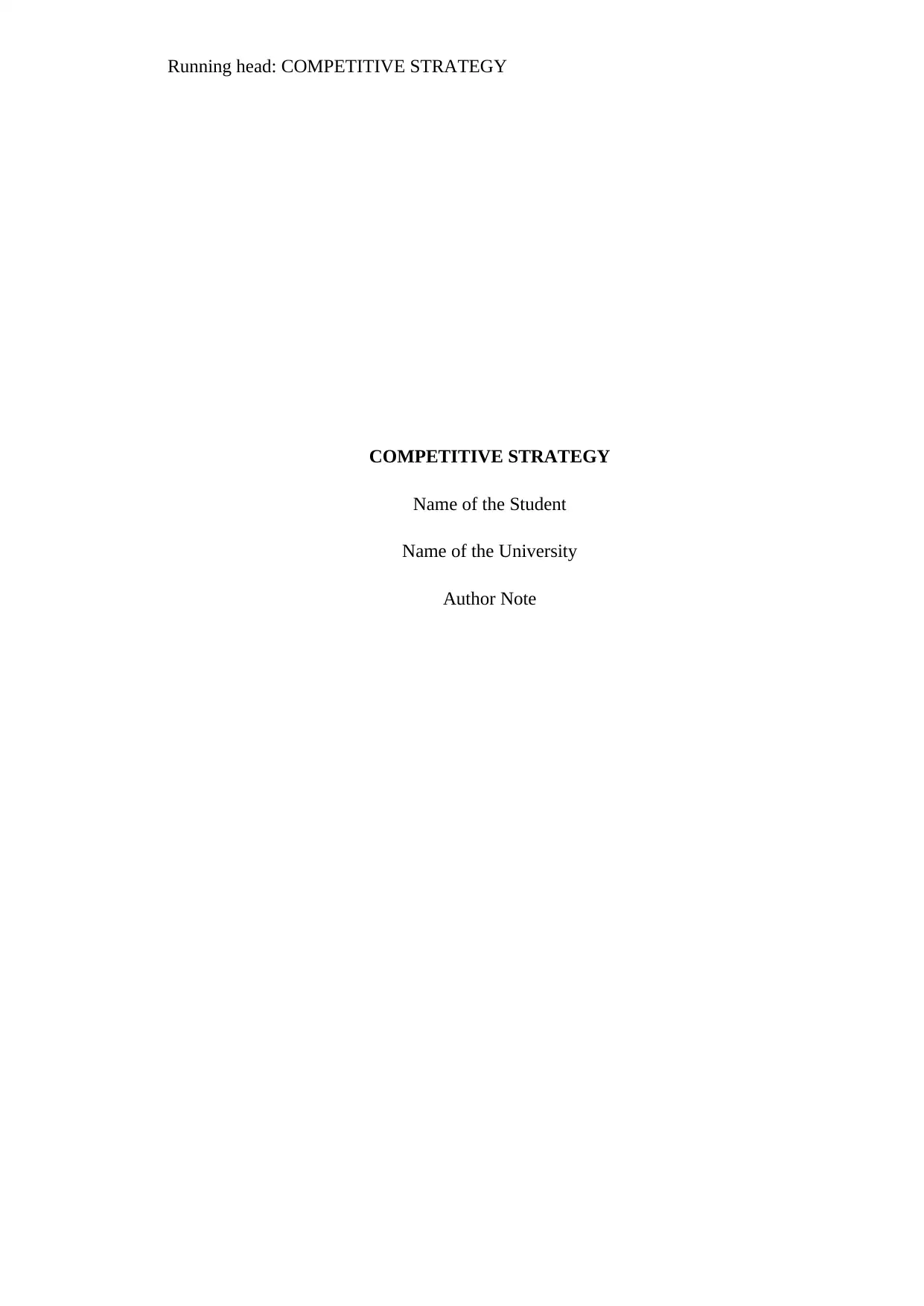
Running head: COMPETITIVE STRATEGY
COMPETITIVE STRATEGY
Name of the Student
Name of the University
Author Note
COMPETITIVE STRATEGY
Name of the Student
Name of the University
Author Note
Paraphrase This Document
Need a fresh take? Get an instant paraphrase of this document with our AI Paraphraser
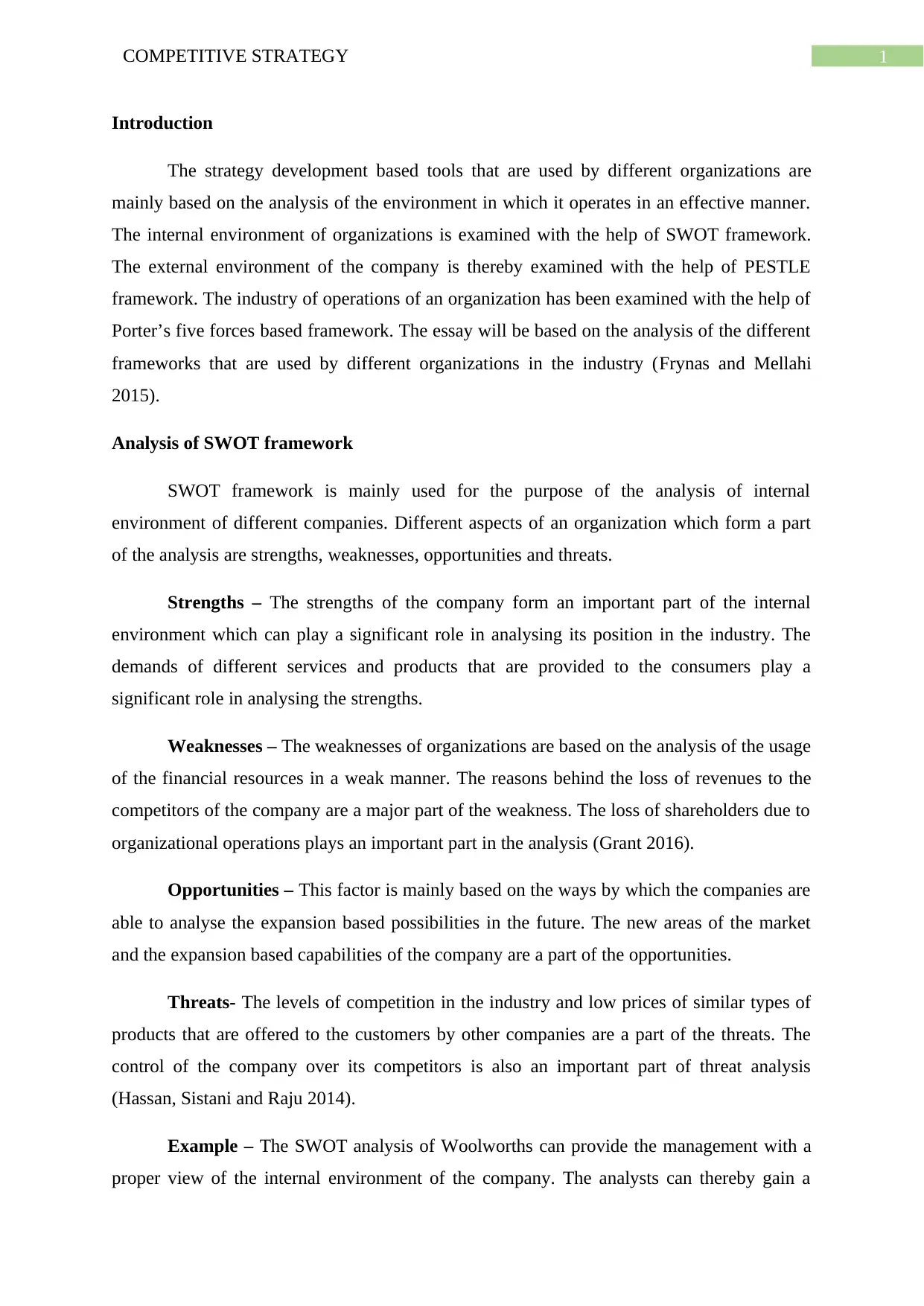
1COMPETITIVE STRATEGY
Introduction
The strategy development based tools that are used by different organizations are
mainly based on the analysis of the environment in which it operates in an effective manner.
The internal environment of organizations is examined with the help of SWOT framework.
The external environment of the company is thereby examined with the help of PESTLE
framework. The industry of operations of an organization has been examined with the help of
Porter’s five forces based framework. The essay will be based on the analysis of the different
frameworks that are used by different organizations in the industry (Frynas and Mellahi
2015).
Analysis of SWOT framework
SWOT framework is mainly used for the purpose of the analysis of internal
environment of different companies. Different aspects of an organization which form a part
of the analysis are strengths, weaknesses, opportunities and threats.
Strengths – The strengths of the company form an important part of the internal
environment which can play a significant role in analysing its position in the industry. The
demands of different services and products that are provided to the consumers play a
significant role in analysing the strengths.
Weaknesses – The weaknesses of organizations are based on the analysis of the usage
of the financial resources in a weak manner. The reasons behind the loss of revenues to the
competitors of the company are a major part of the weakness. The loss of shareholders due to
organizational operations plays an important part in the analysis (Grant 2016).
Opportunities – This factor is mainly based on the ways by which the companies are
able to analyse the expansion based possibilities in the future. The new areas of the market
and the expansion based capabilities of the company are a part of the opportunities.
Threats- The levels of competition in the industry and low prices of similar types of
products that are offered to the customers by other companies are a part of the threats. The
control of the company over its competitors is also an important part of threat analysis
(Hassan, Sistani and Raju 2014).
Example – The SWOT analysis of Woolworths can provide the management with a
proper view of the internal environment of the company. The analysts can thereby gain a
Introduction
The strategy development based tools that are used by different organizations are
mainly based on the analysis of the environment in which it operates in an effective manner.
The internal environment of organizations is examined with the help of SWOT framework.
The external environment of the company is thereby examined with the help of PESTLE
framework. The industry of operations of an organization has been examined with the help of
Porter’s five forces based framework. The essay will be based on the analysis of the different
frameworks that are used by different organizations in the industry (Frynas and Mellahi
2015).
Analysis of SWOT framework
SWOT framework is mainly used for the purpose of the analysis of internal
environment of different companies. Different aspects of an organization which form a part
of the analysis are strengths, weaknesses, opportunities and threats.
Strengths – The strengths of the company form an important part of the internal
environment which can play a significant role in analysing its position in the industry. The
demands of different services and products that are provided to the consumers play a
significant role in analysing the strengths.
Weaknesses – The weaknesses of organizations are based on the analysis of the usage
of the financial resources in a weak manner. The reasons behind the loss of revenues to the
competitors of the company are a major part of the weakness. The loss of shareholders due to
organizational operations plays an important part in the analysis (Grant 2016).
Opportunities – This factor is mainly based on the ways by which the companies are
able to analyse the expansion based possibilities in the future. The new areas of the market
and the expansion based capabilities of the company are a part of the opportunities.
Threats- The levels of competition in the industry and low prices of similar types of
products that are offered to the customers by other companies are a part of the threats. The
control of the company over its competitors is also an important part of threat analysis
(Hassan, Sistani and Raju 2014).
Example – The SWOT analysis of Woolworths can provide the management with a
proper view of the internal environment of the company. The analysts can thereby gain a
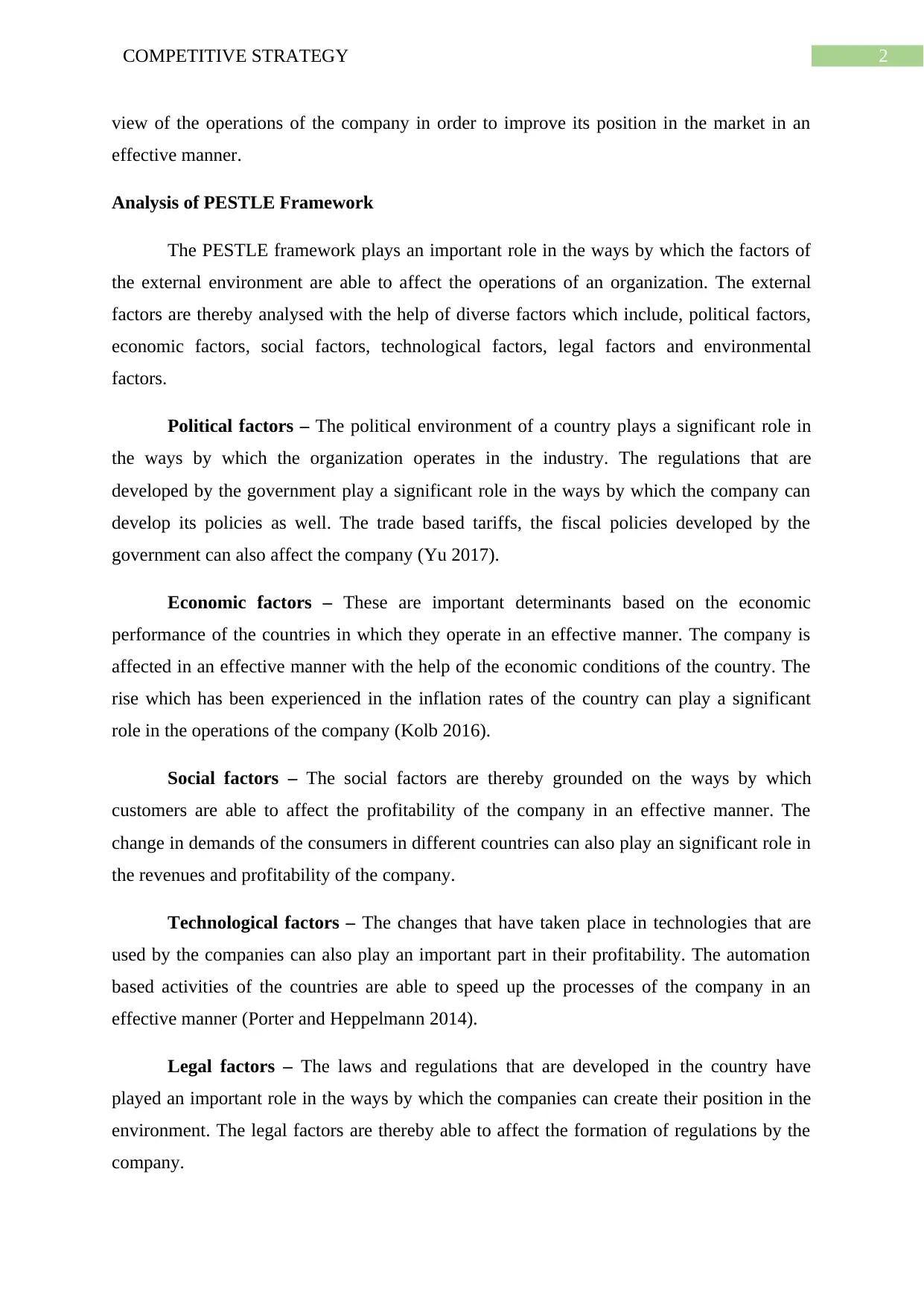
2COMPETITIVE STRATEGY
view of the operations of the company in order to improve its position in the market in an
effective manner.
Analysis of PESTLE Framework
The PESTLE framework plays an important role in the ways by which the factors of
the external environment are able to affect the operations of an organization. The external
factors are thereby analysed with the help of diverse factors which include, political factors,
economic factors, social factors, technological factors, legal factors and environmental
factors.
Political factors – The political environment of a country plays a significant role in
the ways by which the organization operates in the industry. The regulations that are
developed by the government play a significant role in the ways by which the company can
develop its policies as well. The trade based tariffs, the fiscal policies developed by the
government can also affect the company (Yu 2017).
Economic factors – These are important determinants based on the economic
performance of the countries in which they operate in an effective manner. The company is
affected in an effective manner with the help of the economic conditions of the country. The
rise which has been experienced in the inflation rates of the country can play a significant
role in the operations of the company (Kolb 2016).
Social factors – The social factors are thereby grounded on the ways by which
customers are able to affect the profitability of the company in an effective manner. The
change in demands of the consumers in different countries can also play an significant role in
the revenues and profitability of the company.
Technological factors – The changes that have taken place in technologies that are
used by the companies can also play an important part in their profitability. The automation
based activities of the countries are able to speed up the processes of the company in an
effective manner (Porter and Heppelmann 2014).
Legal factors – The laws and regulations that are developed in the country have
played an important role in the ways by which the companies can create their position in the
environment. The legal factors are thereby able to affect the formation of regulations by the
company.
view of the operations of the company in order to improve its position in the market in an
effective manner.
Analysis of PESTLE Framework
The PESTLE framework plays an important role in the ways by which the factors of
the external environment are able to affect the operations of an organization. The external
factors are thereby analysed with the help of diverse factors which include, political factors,
economic factors, social factors, technological factors, legal factors and environmental
factors.
Political factors – The political environment of a country plays a significant role in
the ways by which the organization operates in the industry. The regulations that are
developed by the government play a significant role in the ways by which the company can
develop its policies as well. The trade based tariffs, the fiscal policies developed by the
government can also affect the company (Yu 2017).
Economic factors – These are important determinants based on the economic
performance of the countries in which they operate in an effective manner. The company is
affected in an effective manner with the help of the economic conditions of the country. The
rise which has been experienced in the inflation rates of the country can play a significant
role in the operations of the company (Kolb 2016).
Social factors – The social factors are thereby grounded on the ways by which
customers are able to affect the profitability of the company in an effective manner. The
change in demands of the consumers in different countries can also play an significant role in
the revenues and profitability of the company.
Technological factors – The changes that have taken place in technologies that are
used by the companies can also play an important part in their profitability. The automation
based activities of the countries are able to speed up the processes of the company in an
effective manner (Porter and Heppelmann 2014).
Legal factors – The laws and regulations that are developed in the country have
played an important role in the ways by which the companies can create their position in the
environment. The legal factors are thereby able to affect the formation of regulations by the
company.
⊘ This is a preview!⊘
Do you want full access?
Subscribe today to unlock all pages.

Trusted by 1+ million students worldwide
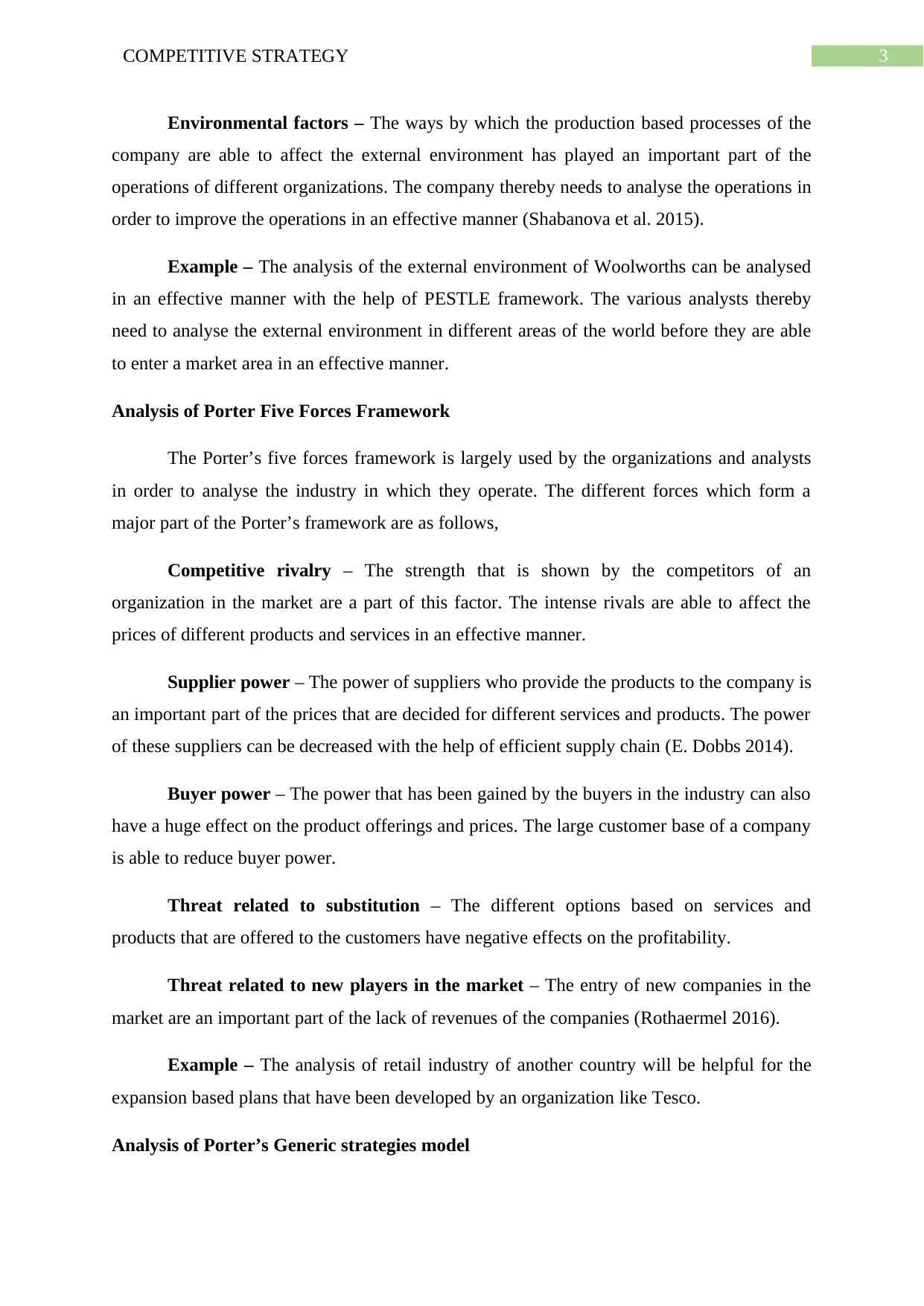
3COMPETITIVE STRATEGY
Environmental factors – The ways by which the production based processes of the
company are able to affect the external environment has played an important part of the
operations of different organizations. The company thereby needs to analyse the operations in
order to improve the operations in an effective manner (Shabanova et al. 2015).
Example – The analysis of the external environment of Woolworths can be analysed
in an effective manner with the help of PESTLE framework. The various analysts thereby
need to analyse the external environment in different areas of the world before they are able
to enter a market area in an effective manner.
Analysis of Porter Five Forces Framework
The Porter’s five forces framework is largely used by the organizations and analysts
in order to analyse the industry in which they operate. The different forces which form a
major part of the Porter’s framework are as follows,
Competitive rivalry – The strength that is shown by the competitors of an
organization in the market are a part of this factor. The intense rivals are able to affect the
prices of different products and services in an effective manner.
Supplier power – The power of suppliers who provide the products to the company is
an important part of the prices that are decided for different services and products. The power
of these suppliers can be decreased with the help of efficient supply chain (E. Dobbs 2014).
Buyer power – The power that has been gained by the buyers in the industry can also
have a huge effect on the product offerings and prices. The large customer base of a company
is able to reduce buyer power.
Threat related to substitution – The different options based on services and
products that are offered to the customers have negative effects on the profitability.
Threat related to new players in the market – The entry of new companies in the
market are an important part of the lack of revenues of the companies (Rothaermel 2016).
Example – The analysis of retail industry of another country will be helpful for the
expansion based plans that have been developed by an organization like Tesco.
Analysis of Porter’s Generic strategies model
Environmental factors – The ways by which the production based processes of the
company are able to affect the external environment has played an important part of the
operations of different organizations. The company thereby needs to analyse the operations in
order to improve the operations in an effective manner (Shabanova et al. 2015).
Example – The analysis of the external environment of Woolworths can be analysed
in an effective manner with the help of PESTLE framework. The various analysts thereby
need to analyse the external environment in different areas of the world before they are able
to enter a market area in an effective manner.
Analysis of Porter Five Forces Framework
The Porter’s five forces framework is largely used by the organizations and analysts
in order to analyse the industry in which they operate. The different forces which form a
major part of the Porter’s framework are as follows,
Competitive rivalry – The strength that is shown by the competitors of an
organization in the market are a part of this factor. The intense rivals are able to affect the
prices of different products and services in an effective manner.
Supplier power – The power of suppliers who provide the products to the company is
an important part of the prices that are decided for different services and products. The power
of these suppliers can be decreased with the help of efficient supply chain (E. Dobbs 2014).
Buyer power – The power that has been gained by the buyers in the industry can also
have a huge effect on the product offerings and prices. The large customer base of a company
is able to reduce buyer power.
Threat related to substitution – The different options based on services and
products that are offered to the customers have negative effects on the profitability.
Threat related to new players in the market – The entry of new companies in the
market are an important part of the lack of revenues of the companies (Rothaermel 2016).
Example – The analysis of retail industry of another country will be helpful for the
expansion based plans that have been developed by an organization like Tesco.
Analysis of Porter’s Generic strategies model
Paraphrase This Document
Need a fresh take? Get an instant paraphrase of this document with our AI Paraphraser
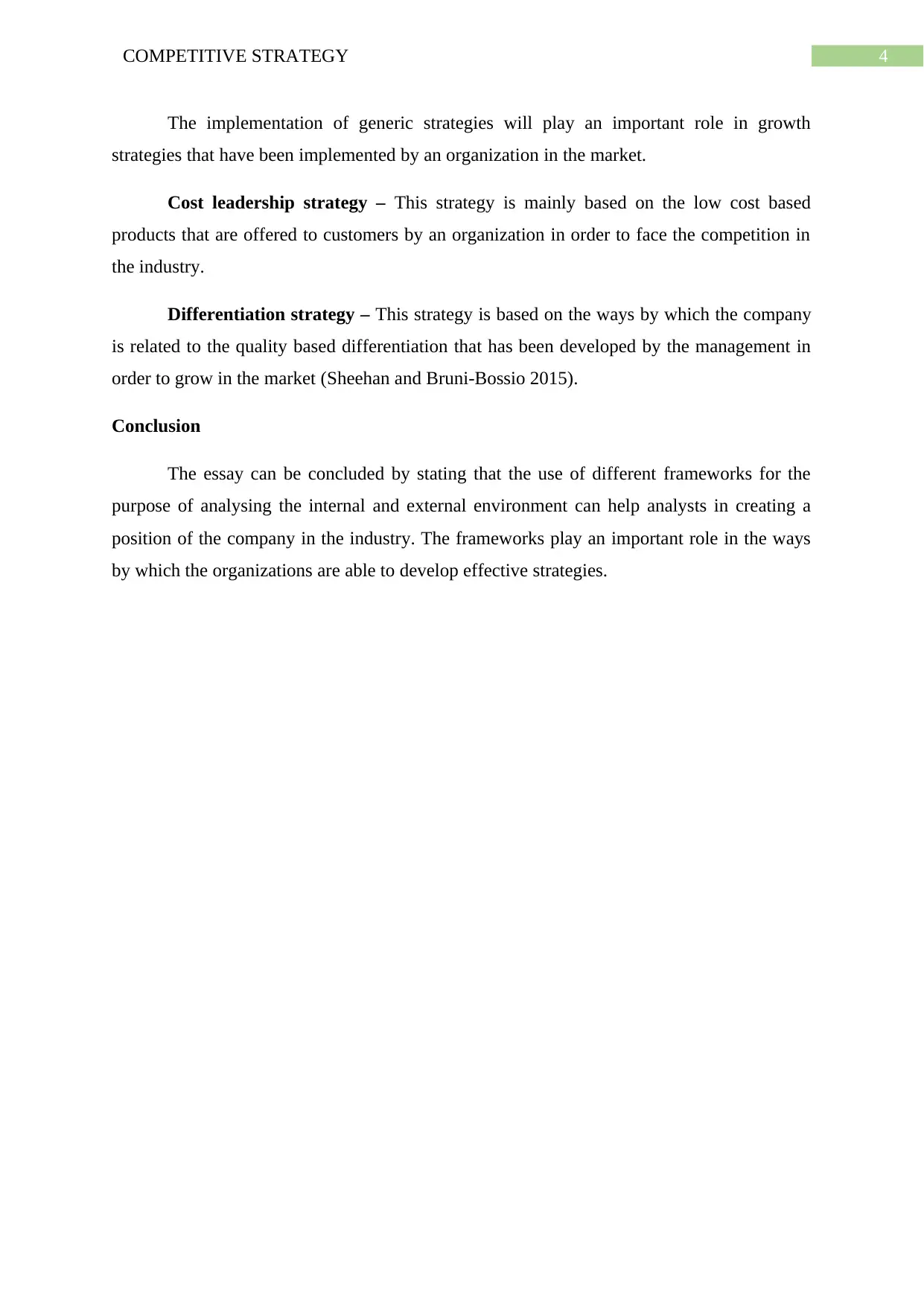
4COMPETITIVE STRATEGY
The implementation of generic strategies will play an important role in growth
strategies that have been implemented by an organization in the market.
Cost leadership strategy – This strategy is mainly based on the low cost based
products that are offered to customers by an organization in order to face the competition in
the industry.
Differentiation strategy – This strategy is based on the ways by which the company
is related to the quality based differentiation that has been developed by the management in
order to grow in the market (Sheehan and Bruni-Bossio 2015).
Conclusion
The essay can be concluded by stating that the use of different frameworks for the
purpose of analysing the internal and external environment can help analysts in creating a
position of the company in the industry. The frameworks play an important role in the ways
by which the organizations are able to develop effective strategies.
The implementation of generic strategies will play an important role in growth
strategies that have been implemented by an organization in the market.
Cost leadership strategy – This strategy is mainly based on the low cost based
products that are offered to customers by an organization in order to face the competition in
the industry.
Differentiation strategy – This strategy is based on the ways by which the company
is related to the quality based differentiation that has been developed by the management in
order to grow in the market (Sheehan and Bruni-Bossio 2015).
Conclusion
The essay can be concluded by stating that the use of different frameworks for the
purpose of analysing the internal and external environment can help analysts in creating a
position of the company in the industry. The frameworks play an important role in the ways
by which the organizations are able to develop effective strategies.
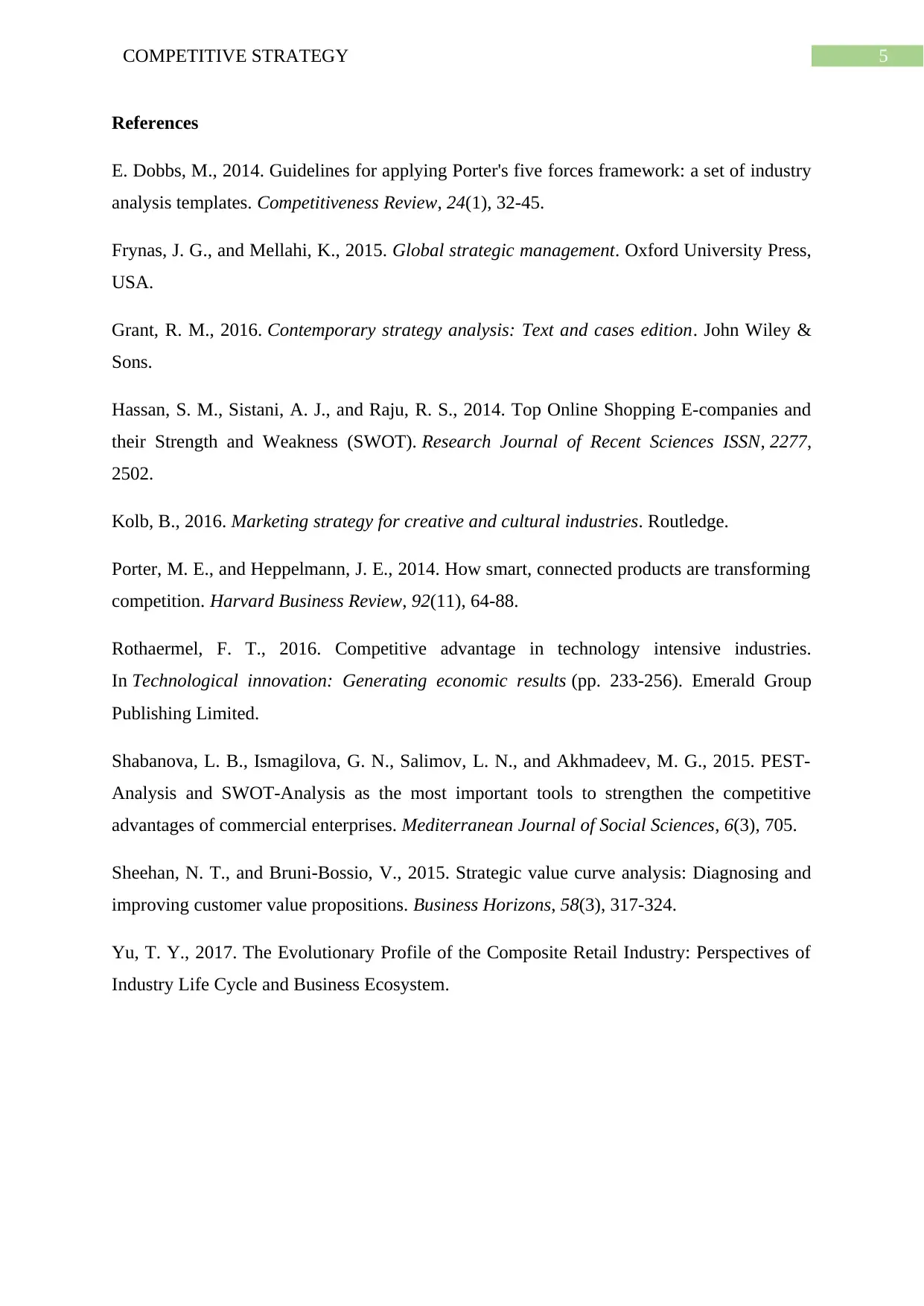
5COMPETITIVE STRATEGY
References
E. Dobbs, M., 2014. Guidelines for applying Porter's five forces framework: a set of industry
analysis templates. Competitiveness Review, 24(1), 32-45.
Frynas, J. G., and Mellahi, K., 2015. Global strategic management. Oxford University Press,
USA.
Grant, R. M., 2016. Contemporary strategy analysis: Text and cases edition. John Wiley &
Sons.
Hassan, S. M., Sistani, A. J., and Raju, R. S., 2014. Top Online Shopping E-companies and
their Strength and Weakness (SWOT). Research Journal of Recent Sciences ISSN, 2277,
2502.
Kolb, B., 2016. Marketing strategy for creative and cultural industries. Routledge.
Porter, M. E., and Heppelmann, J. E., 2014. How smart, connected products are transforming
competition. Harvard Business Review, 92(11), 64-88.
Rothaermel, F. T., 2016. Competitive advantage in technology intensive industries.
In Technological innovation: Generating economic results (pp. 233-256). Emerald Group
Publishing Limited.
Shabanova, L. B., Ismagilova, G. N., Salimov, L. N., and Akhmadeev, M. G., 2015. PEST-
Analysis and SWOT-Analysis as the most important tools to strengthen the competitive
advantages of commercial enterprises. Mediterranean Journal of Social Sciences, 6(3), 705.
Sheehan, N. T., and Bruni-Bossio, V., 2015. Strategic value curve analysis: Diagnosing and
improving customer value propositions. Business Horizons, 58(3), 317-324.
Yu, T. Y., 2017. The Evolutionary Profile of the Composite Retail Industry: Perspectives of
Industry Life Cycle and Business Ecosystem.
References
E. Dobbs, M., 2014. Guidelines for applying Porter's five forces framework: a set of industry
analysis templates. Competitiveness Review, 24(1), 32-45.
Frynas, J. G., and Mellahi, K., 2015. Global strategic management. Oxford University Press,
USA.
Grant, R. M., 2016. Contemporary strategy analysis: Text and cases edition. John Wiley &
Sons.
Hassan, S. M., Sistani, A. J., and Raju, R. S., 2014. Top Online Shopping E-companies and
their Strength and Weakness (SWOT). Research Journal of Recent Sciences ISSN, 2277,
2502.
Kolb, B., 2016. Marketing strategy for creative and cultural industries. Routledge.
Porter, M. E., and Heppelmann, J. E., 2014. How smart, connected products are transforming
competition. Harvard Business Review, 92(11), 64-88.
Rothaermel, F. T., 2016. Competitive advantage in technology intensive industries.
In Technological innovation: Generating economic results (pp. 233-256). Emerald Group
Publishing Limited.
Shabanova, L. B., Ismagilova, G. N., Salimov, L. N., and Akhmadeev, M. G., 2015. PEST-
Analysis and SWOT-Analysis as the most important tools to strengthen the competitive
advantages of commercial enterprises. Mediterranean Journal of Social Sciences, 6(3), 705.
Sheehan, N. T., and Bruni-Bossio, V., 2015. Strategic value curve analysis: Diagnosing and
improving customer value propositions. Business Horizons, 58(3), 317-324.
Yu, T. Y., 2017. The Evolutionary Profile of the Composite Retail Industry: Perspectives of
Industry Life Cycle and Business Ecosystem.
⊘ This is a preview!⊘
Do you want full access?
Subscribe today to unlock all pages.

Trusted by 1+ million students worldwide
1 out of 6
Related Documents
Your All-in-One AI-Powered Toolkit for Academic Success.
+13062052269
info@desklib.com
Available 24*7 on WhatsApp / Email
![[object Object]](/_next/static/media/star-bottom.7253800d.svg)
Unlock your academic potential
Copyright © 2020–2025 A2Z Services. All Rights Reserved. Developed and managed by ZUCOL.




